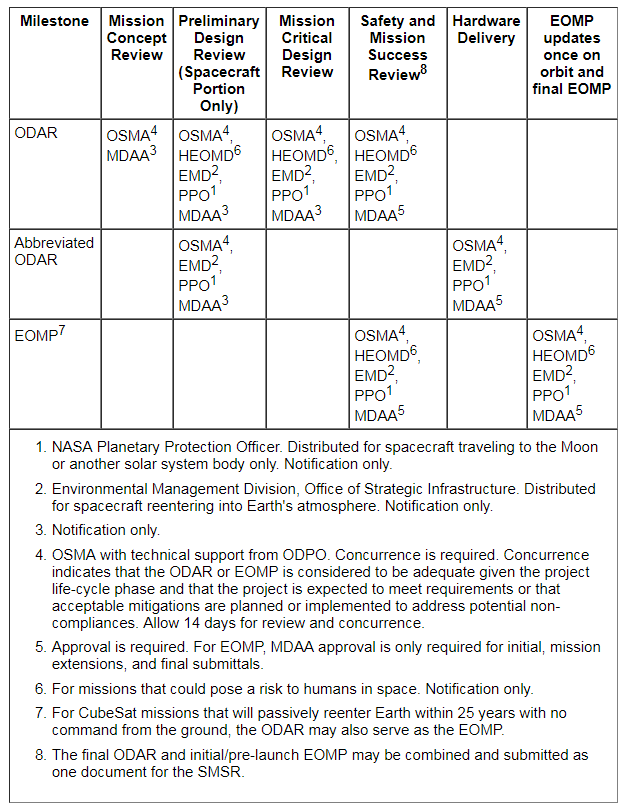The four guiding principles in the U.S. Government Orbital Debris Mitigation Standard Practices, approved in 2001, are to
limit the generation of mission-related debris, accidental explosions and collisions, and to conduct postmission disposal.
Both the 2006 and 2010 U.S. National Space Policies directed U.S. government departments and agencies to implement the
standard practices to limit the generation of new debris by their space missions.
NPR 8715.6, NASA Procedural Requirements for Limiting Orbital Debris and Evaluating the Meteoroid and Orbital Debris
Environments and
NASA-STD-8719.14, Process for Limiting Orbital Debris represent the agency’s implementation of the standard
practices.
When NASA launches a payload into space, there must be a plan for operating and decommissioning the launch vehicle upper
stage and the spacecraft in a manner that complies with NPR 8715.6 and NASA-STD-8719.14 to limit the risk of orbital
debris generation to a minimum.
“Orbital Debris mitigation is the best and the most cost-effective means to manage the Orbital Debris problem
and preserve the near-Earth space environment for the safe operations of future missions,” said Dr. J.-C. Liou,
chief scientist for Orbital Debris.
ODARs and EOMPs
To document the implementation of the NASA-specific Orbital Debris mitigation requirements, NASA missions prepare Orbital
Debris Assessment Reports (ODARs) and End of Mission Plans (EOMPs). ODARs are developed prior to launch, while EOMPs
are completed while the payload is in space. Although content from EOMPs is included in ODARs, plans often change during
the life of a payload. EOMPs are maintained to ensure that spacecraft continue to meet orbital debris mitigation requirements
even when missions are extended beyond the original plans and fuel reserves become less and systems fail.
When NASA is only responsible for the delivery of hardware to a non-NASA spacecraft integrator, a full ODAR is not required
and an abbreviated ODAR containing the Orbital Debris assessment information relevant to the integrating partner organization
is sufficient.
Given the significance of the Orbital Debris problem to NASA and others operating in space, ODARs and EOMPs undergo an agency-level
review by OSMA, supported by the Orbital Debris Program Office. NASA reviews payloads developed or operated by NASA,
under contract from NASA, or under agreement with NASA. Exceptions include launch vehicles, payloads or vehicles licensed
by other federal agencies with authority to oversee Orbital Debris mitigation, such as commercial launch vehicles licensed
by the Federal Aviation Administration or orbital vehicles licensed by the Federal Communications Commission. In cases
where NASA contributes an instrument or other element to a mission led by another space agency, OSMA still reviews the
abbreviated debris assessment to ensure that the agency does not deliver hardware known to violate Orbital Debris mitigation
principles.
Primary payload projects submit their documents through the responsible Mission Directorate. ODARs for secondary payloads,
such as CubeSats, on NASA-managed launches (e.g., Launch Services Program or Space Launch System) are submitted via the
launch service providers. The schedule is shown in the following table:

Requirements Table From NPR 8715.6
The specific requirements for ODARs, abbreviated ODARs and EOMPs are outlined in
NPR 8715.6
and
NASA-STD-8719.14
. Requirements outlined include the applicable milestones throughout the project life cycle — Mission Concept Reviews,
Preliminary Design Reviews, Mission Critical Design Reviews, Safety and Mission Success Reviews, hardware delivery,
and post-launch (while in orbit) — as well as the various groups and personnel involved in the reviews —
the Office of Safety and Mission Assurance (OSMA); the Mission Directorate Associate Administrator (MDAA); Human
Exploration and Operations Mission Directorate (HEOMD); Environmental Management Division (EMD), Office of Strategic
Infrastructure; and the Planetary Protection Officer (PPO).
The protection of the orbital environment is a priority not only for NASA, but also for the United States (as evidenced by
the recent Space Policy Directive 3 on Space Traffic Management and Space Situational Awareness) and international community.
OSMA will continue to work with Mission Directorates, programs and projects to ensure NASA does its part in keeping the
generation of Orbital Debris to a minimum.
Questions about ODARs and EOMPs can be direct to
Liou or
Dr. Matt Forsbacka, Micrometeoroid and Orbital Debris Program executive.
For additional information, see “
National Space Policy of the United States of America” and “
U.S. Government Orbital Debris Mitigation Standard Practices.”